Craving something new
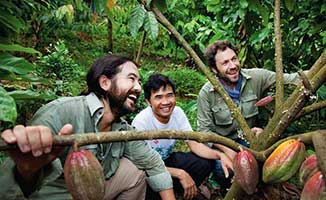
Maruta (left) and Mourou (right) work with a local farmer to source the best cacao. (Image courtesy of Mourou.)
As entrepreneurial hotbeds go, the jungles of Vietnam may not be top of mind. Especially when one is an entrepreneur planning to launch a bean-to-bar chocolate factory. But that’s precisely where the concept for Marou – Faiseurs de Chocolat was formed.
Marou was just a morsel of an idea in 2010 when a pair of French émigrés met during a weekend survival expedition outside Ho Chi Minh City. Vincent Mourou, BS ’94, and Samuel Maruta were both on sabbatical from successful careers – advertising and finance, respectively. Both were intrigued by the vibrant culture of Vietnam. And both had an interest in the country’s burgeoning cocoa industry.
Based on that unlikely connection, the pair became friends. And when Mourou planned a tour of the Southeastern province of Bà Rịa with the goal of exploring a viable cacao farm, he invited Maruta to join him. Cruising the landscape on motorbikes, they followed a quaint sign advertising beans for sale and discovered a well-tended farm with row upon row of Trinitario cacao trees. (Cacao is the term for the raw bean itself; cocoa is the term for the processed product.)
Mourou and Maruta bought a four-pound bag of beans that day, and as they crossed the Dong Nai River via ferry, all Mourou could think was, “So, what’s next?” The question lingered until Maruta, who had a tangential connection to the industry, confidently suggested they start a chocolate-making business. How hard could it possibly be?
A sweet start
Fortunately Maruta’s home was equipped with some rare Western amenities – a blender and an oven – that were essential to the fledgling operation. So the novice candy men got to work in their makeshift “choco-lab,” turning to the Internet for a crash-course in all things chocolate.
They roasted, skinned, and blended their first batch of cacao beans and cooked the mixture in a cake mold. Though rudimentary at best, the processed product spoke volumes. It was still far from chocolate, but Mourou says, “It was extremely powerful, fragrant, and acidulated – with fruit notes unlike anything we had ever tasted before. And it wasn’t bad.”
As the conversation turned to business, Mourou expressed his ideals to his future partner.
“I wanted a certain quality of life,” he says. “I wanted to make something authentic with the highest possible quality, and to only source local ingredients. I wanted it to be about adventure.”
Maruta agreed. And Marou – Faiseurs de Chocolat, a combination of both co-founders’ surnames, had a working mission statement. It was Feb. 1, 2011.
How fitting that Marou is an anagram for “amour” – or love in French. The focus, says Mourou, is on producing pleasure in the form of incomparable dark chocolate, evocative of the mysterious Southern Vietnamese countryside. With each bar, Marou’s founders strive to retain the distinct character of the virgin cacao while following traditional French artisanal methods.
Country of origin
Coffee and rice are counted among Vietnam’s biggest exports, but cacao is now finding its sweet spot in the agricultural value chain. It’s not the first time the nation has looked to cacao farming as an economic driver.
An early investment by the French near the turn of the 20th century dried up soon after; a burst of interest in the 1980s literally died on the vine. But cacao farming appears to be taking hold for real now. The country boasts fertile soil and an ideal climate for a thriving, sustainable industry. And reports from the April 2015 Asia Choco Cocoa Congress in Singapore note that Vietnam’s cocoa production could increase from 4,000 tons annually to as much as 55,000 tons annually within a decade.
Nongovernmental organizations like ACDI/VOCA are active in the region, promoting food security and agricultural development by training small farmers in harvest and post-harvest techniques. Cargill, Mars, and Puratos-Grand Place are just a few multinationals working to grow the cocoa sector. In addition, an increasing number of state-owned plantations are converting to cacao from coffee and rubber, delivering a significant boost to Vietnam’s annual output, according to the daily online news service confectionarynews.com.
On the map
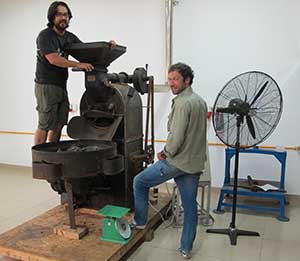
This 1937 Devigne & Janin roaster came from France. It may look antiquated, but it is integral to the process of creating high-quality chocolate. (Image courtesy of Mourou.)
For its part Marou has been boosting Vietnam’s cocoa profile since first scaling up in summer 2011. After a few false starts, zoning snags, and licensing issues, the partners moved out of Maruta’s kitchen and into an industrial building on the outskirts of Ho Chi Minh City. By October they were settled in, complete with a grinding machine from Singapore and a 1937 Devigne & Janin roaster from France (weighing in at more than a ton).
“We thought we had everything going against us,” Mourou says. “We weren’t from the world of chocolate or from a country known for cocoa — not to mention a country known for chocolate. And we didn’t know anybody.”
Producing about 54 batches of chocolate during nine months, the partners ultimately arrived at the Marou formula. Their award-winning package design is ornate and descriptive, detailing the tremendous care invested in each bar. Different varieties reveal unique characteristics that reflect the richness of the soil and climate of each terroir. Distinct flavor notes carry the exotic hint of spices, fruits, honey, and even tobacco.
Candy men
At first Marou depended solely on word-of-mouth promotion throughout Ho Chi Minh City. The first real break came in April 2012 when the global design publication Wallpaper* magazine ran a feature about the company in its popular “handmade” issue. The honor earned Marou an exhibit space during Milan’s Design Week in Italy. That exposure helped the brand go viral, and when a subsequent article appeared in the French newspaper Ouest-France, vendors came calling.
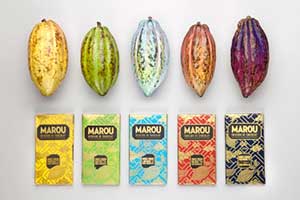
Marou’s hand-wrapped packages are color-coded to correspond with the cacao pods from which the chocolate was generated. Different regions bring different notes of flavor. (Image courtesy of Mourou.)
“We did very little prospecting,” Mourou says. “People came to us and it was extraordinary.”
By June 2012, the partners were exporting product and earning industry recognition. The emerging brand won prestigious awards at the renowned Salon du Chocolat in Paris and the Academy of Chocolate in London in 2012 and 2013.
Marou now counts 25 employees. The company produces about 30,000 bars of chocolate per month. Exports to more than 24 countries, including France, Sweden, and Japan, account for about 70-80 percent of sales. Ann Arbor’s Zingerman’s and Detroit’s Astro Coffee were among Marou’s first U.S. customers.
Product is sourced from about 10 family-owned farms in the Lam Dong province near the Central Highlands; the Tien Giang and Ben Tre provinces in the Mekong Delta; and the Dong Nai and Bà Ria provinces in the Southeast. Notably, the partners continue to source product from the very first farmer who sold them that initial bag of beans.
Breaking the mold

The day’s plentiful supply of cacao beans will soon be transformed into luxurious dark chocolate. (Image courtesy of Mourou.)
Part of Marou’s successful business strategy is that its founders do things their own way, even when it comes to issues regarding Fairtrade certification.
They’ve established close relationships with the farmers and families who supply their cacao beans, Mourou says. And they pay a negotiated fee, “always at a premium over market price,” directly to the growers.
“Farmers benefit much, much more from direct trade,” Mourou says. “It is the best way to make a positive impact and the best method available today.”
Fairtrade certification is designed to ensure farmers receive a good price for their product with respect to costs, profit, market prices, and quality. But being certified Fairtrade is an expensive and arduous process, says Mourou. So instead of paying for the label as a selling point, he and Maruta proudly “live fair trade” every day.
“We are already selling quality, transparency, authenticity, and experience,” he says.
Next they plan to venture into the Central Highlands province of Dak Lak on a quest to add more distinctive flavors to their expanding line of dark chocolates.
“This has been the most extraordinary period of my life,” Mourou says. “I have been in a state of bewilderment the last three years.”
Follow Marou on Twitter @marouchocolate

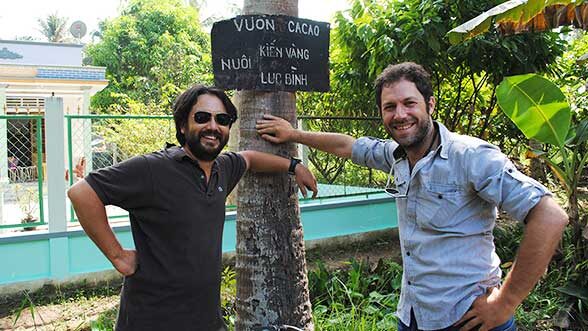
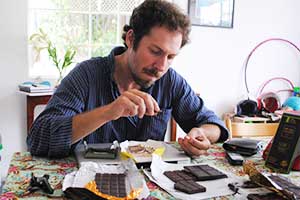



Nancie Gwatkin - 1973
The bars sound delicious. Any suggestions on where to order some online?
Reply
Evan Pougnet - 2009
Nancy,
As informed by Vincent, you can buy their Marou chocolates online two ways if there is not a retailer selling them nearby:
http://darkchocolateimports.com
or
http://www.caputosdeli.com/chocolates/#/?_=1&filter.brand_name=Marou%20Fine%20Chocolate&page=1
And you can find a list of retailers by country and state here on their website:
http://marouchocolate.com/post/55952867959/where-to-buy
Hope this helps! Their chocolates are fantastic!
Thanks,
Evan
Reply
Henry Lowendorf - 1964
Helping Vietnam overcome the decades of forced underdevelopment, exploitation, colonialism and wars of aggression from France and the US is laudable. Few would complain about establishing a chocolate industry.
USAID, however, is not a nongovernmental organization. ACDI/VOCA also gets funding from USAID. It is a CIA front that works out of the US State Department. As such its likely role is to accomplish in Vietnam through subterfuge what the Pentagon and CIA failed to accomplish through direct violence in the years 1956 to 1975. Vietnam is still recovering from the wounds of French and US colonialism/imperialism.
Those who read this journal should not expect that US government and USAID involvement in the chocolate enterprise is benign.
Reply
William Allen
Conspiracy theories get you nowhere old man. Leave politics out of this article.
Reply